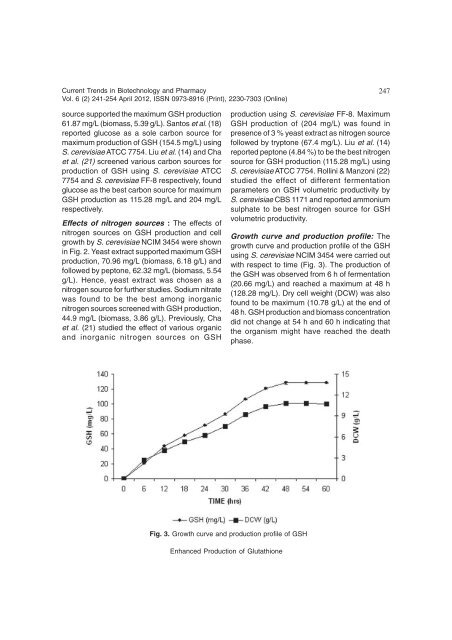d(GC) - Association of Biotechnology and Pharmacy
d(GC) - Association of Biotechnology and Pharmacy
d(GC) - Association of Biotechnology and Pharmacy
You also want an ePaper? Increase the reach of your titles
YUMPU automatically turns print PDFs into web optimized ePapers that Google loves.
Current Trends in <strong>Biotechnology</strong> <strong>and</strong> <strong>Pharmacy</strong><br />
Vol. 6 (2) 241-254 April 2012, ISSN 0973-8916 (Print), 2230-7303 (Online)<br />
source supported the maximum GSH production<br />
61.87 mg/L (biomass, 5.39 g/L). Santos et al. (18)<br />
reported glucose as a sole carbon source for<br />
maximum production <strong>of</strong> GSH (154.5 mg/L) using<br />
S. cerevisiae ATCC 7754. Liu et al. (14) <strong>and</strong> Cha<br />
et al. (21) screened various carbon sources for<br />
production <strong>of</strong> GSH using S. cerevisiae ATCC<br />
7754 <strong>and</strong> S. cerevisiae FF-8 respectively, found<br />
glucose as the best carbon source for maximum<br />
GSH production as 115.28 mg/L <strong>and</strong> 204 mg/L<br />
respectively.<br />
Effects <strong>of</strong> nitrogen sources : The effects <strong>of</strong><br />
nitrogen sources on GSH production <strong>and</strong> cell<br />
growth by S. cerevisiae NCIM 3454 were shown<br />
in Fig. 2. Yeast extract supported maximum GSH<br />
production, 70.96 mg/L (biomass, 6.18 g/L) <strong>and</strong><br />
followed by peptone, 62.32 mg/L (biomass, 5.54<br />
g/L). Hence, yeast extract was chosen as a<br />
nitrogen source for further studies. Sodium nitrate<br />
was found to be the best among inorganic<br />
nitrogen sources screened with GSH production,<br />
44.9 mg/L (biomass, 3.86 g/L). Previously, Cha<br />
et al. (21) studied the effect <strong>of</strong> various organic<br />
<strong>and</strong> inorganic nitrogen sources on GSH<br />
Fig. 3. Growth curve <strong>and</strong> production pr<strong>of</strong>ile <strong>of</strong> GSH<br />
Enhanced Production <strong>of</strong> Glutathione<br />
247<br />
production using S. cerevisiae FF-8. Maximum<br />
GSH production <strong>of</strong> (204 mg/L) was found in<br />
presence <strong>of</strong> 3 % yeast extract as nitrogen source<br />
followed by tryptone (67.4 mg/L). Liu et al. (14)<br />
reported peptone (4.84 %) to be the best nitrogen<br />
source for GSH production (115.28 mg/L) using<br />
S. cerevisiae ATCC 7754. Rollini & Manzoni (22)<br />
studied the effect <strong>of</strong> different fermentation<br />
parameters on GSH volumetric productivity by<br />
S. cerevisiae CBS 1171 <strong>and</strong> reported ammonium<br />
sulphate to be best nitrogen source for GSH<br />
volumetric productivity.<br />
Growth curve <strong>and</strong> production pr<strong>of</strong>ile: The<br />
growth curve <strong>and</strong> production pr<strong>of</strong>ile <strong>of</strong> the GSH<br />
using S. cerevisiae NCIM 3454 were carried out<br />
with respect to time (Fig. 3). The production <strong>of</strong><br />
the GSH was observed from 6 h <strong>of</strong> fermentation<br />
(20.66 mg/L) <strong>and</strong> reached a maximum at 48 h<br />
(128.28 mg/L). Dry cell weight (DCW) was also<br />
found to be maximum (10.78 g/L) at the end <strong>of</strong><br />
48 h. GSH production <strong>and</strong> biomass concentration<br />
did not change at 54 h <strong>and</strong> 60 h indicating that<br />
the organism might have reached the death<br />
phase.













